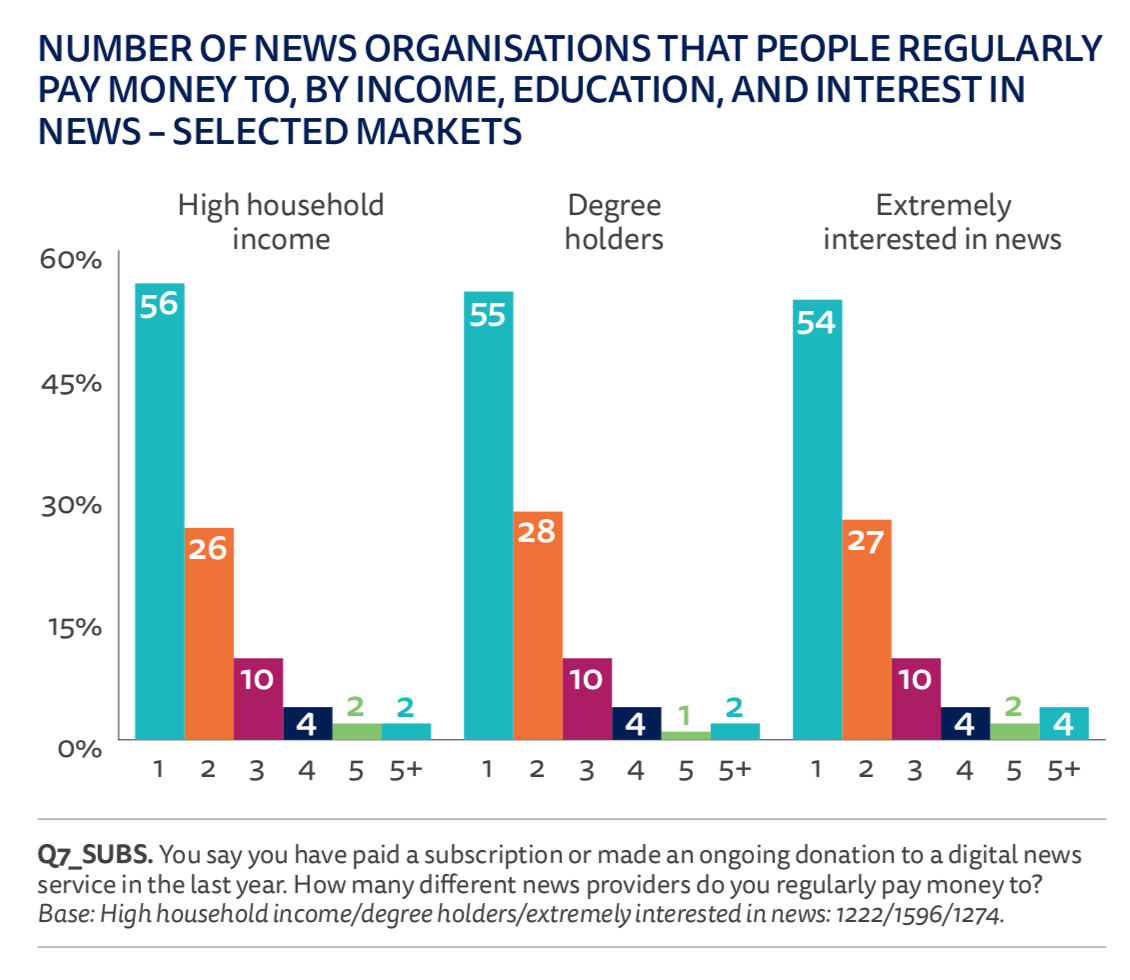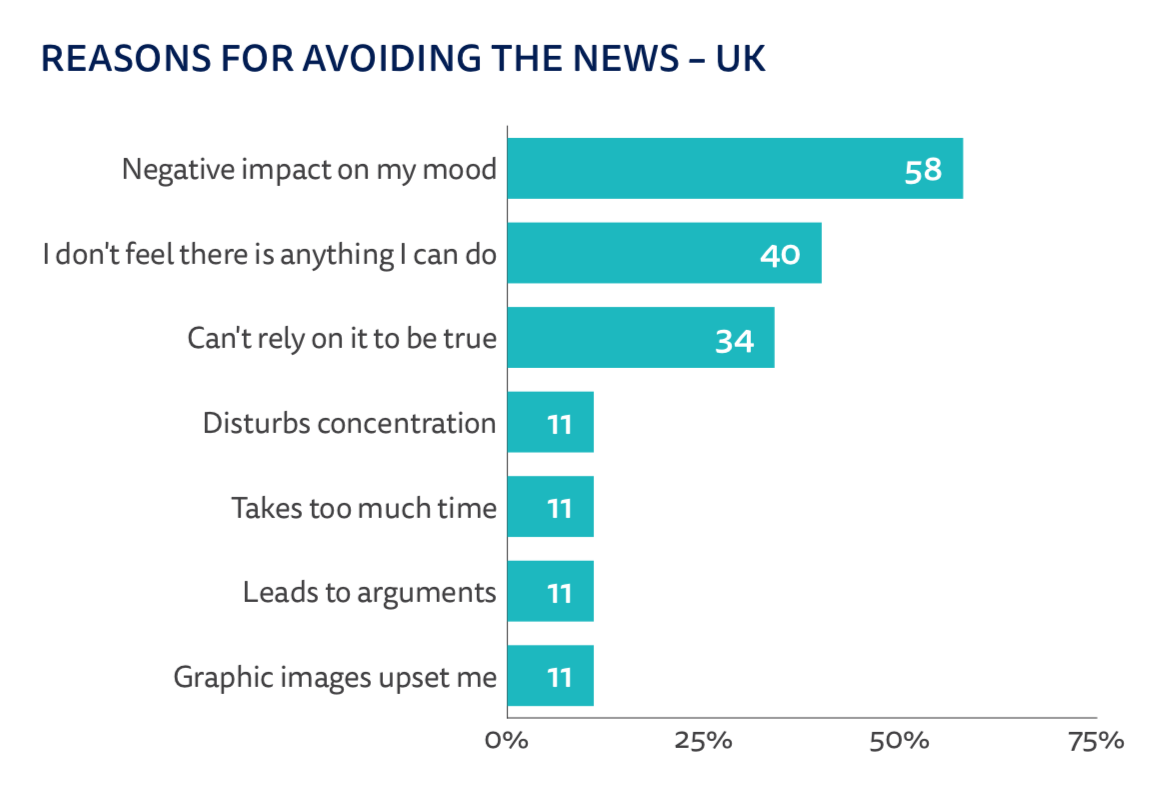
Publishers worldwide are installing paywalls, but many — even most — won’t succeed. Private WhatsApp groups are becoming the default for sharing and discussing news in non-Western countries. Trust in the media is down worldwide. And more people say they avoid the news now than did in 2016, with a particularly large increase in news avoidance in the U.K.
These are some of the findings from a big new report out Tuesday evening from Oxford’s Reuters Institute for the Study of Journalism. The Reuters Institute’s Digital News Report for 2019 surveyed more than 75,000 people in 38 countries about their digital news consumption. (Included in the report for the first time this year: South Africa.)
The research is based on YouGov surveys conducted earlier this year, followed by in-person interviews with young people in the U.S. and U.K. The report includes a number of findings on fake news, misinformation, and trust in the media, which I’ll include in this week’s in Friday’s fake news column.
Here are some of the most interesting findings from the report:
As publishers worldwide put up paywalls and start requiring payment for their content — about 50 percent of respondents in the U.S, Denmark, Australia, and the Netherlands say they bump into one or more paywalls each week when reading news; that figure is 70 percent in Norway — “we find only a small increase in the numbers paying for any online news — whether by subscription, membership, or donation,” the researchers write. Following the Trump bump of 2017, the percentage of U.S. respondents who pay for news in the U.S. is stable at 16%, and stable at 11% in an average of nine other countries. Norway and Sweden are seeing particular success in getting people to pay up — and “industry data reveal that Norwegians and Swedes are prepared to pay online for tabloid titles VG and Aftenbladet (premium models) as well as more upmarket titles such as AftenPosten and Dagens Nyheter.”
In the U.S., by contrast, “the main subscription focus has been at the quality end of the market.” The people who pay for news in the U.S. are wealthier and better educated than those who do not.
No matter how rich and educated they are, though, most people are only paying for one subscription. “The average (median) number of news subscriptions per person among those that pay is one in almost every country.”

The researchers see a “positive development” in the fact that most payments for news are now “ongoing” payments; “at the same time, one-off payments have stagnated” (see ya, Blendle).

From the report:
Our own data this year show that 42% of U.S. digital subscribers have used one or more email newsletters in the last week compared with 35% in the U.K. but just 17% in Norway and 19% in Sweden…
Email remains extremely effective with older, highly engaged news users, even if overall usage has not grown over the last five years. By contrast, mobile notifications tend to be used by younger groups and have shown considerable growth in weekly use — up from 3% to 20% in the U.K. and 6% to 19% in the U.S. since 2014.
People continue to shift to closed social platforms and messaging apps.

Most Facebook and WhatsApp groups don’t focus on news. But people who do join news groups are different from those who do not. “They are significantly more likely to use an alternative or partisan news source than those who do not use groups for news,” the researchers note. Members of news and politics groups on Facebook and WhatsApp are also more likely to say that “trust news in social media most of the time.”

Thirty-two percent of respondents said they often or sometimes actively avoid the news, up from 29% in 2017. There’s been a particularly large increase in news avoidance in the U.K., where “news avoidance has grown 11 percentage points mainly due to frustration over the intractable and polarizing nature of Brexit.”
When asked about the type of news avoided, more than two-thirds (71%) cited Brexit coverage, followed by other types of politics (35%), and then sports news (28%). The majority of open-ended responses also mentioned frustration or sadness over Brexit.

For this report, Reuters paid special attention to people under 35 in the U.S. and U.K.; a separate and more detailed report on this will be released in September. The researchers (with the help of a market research group) looked at differences in news consumption behavior among 18- to 24-year-olds, 25- to 34-year-olds, and people over 35.
18- to 24-year-olds are quite a bit more likely to say that their first contact with news in the morning comes on a smartphone — and when they pick up their phones for news, they are a lot more likely to go to social media (including messaging groups) than to a publisher’s app.

“No news app was within the top 25 apps used by all the respondents in the study, whereas Instagram was the application found on almost all phones with the highest use in terms of daily minutes used,” the researchers note. They also find that while Instagram is playing a role in popularizing news video, 18- to 24-year-olds continue to prefer text over video (58%).
You can read the full report here.